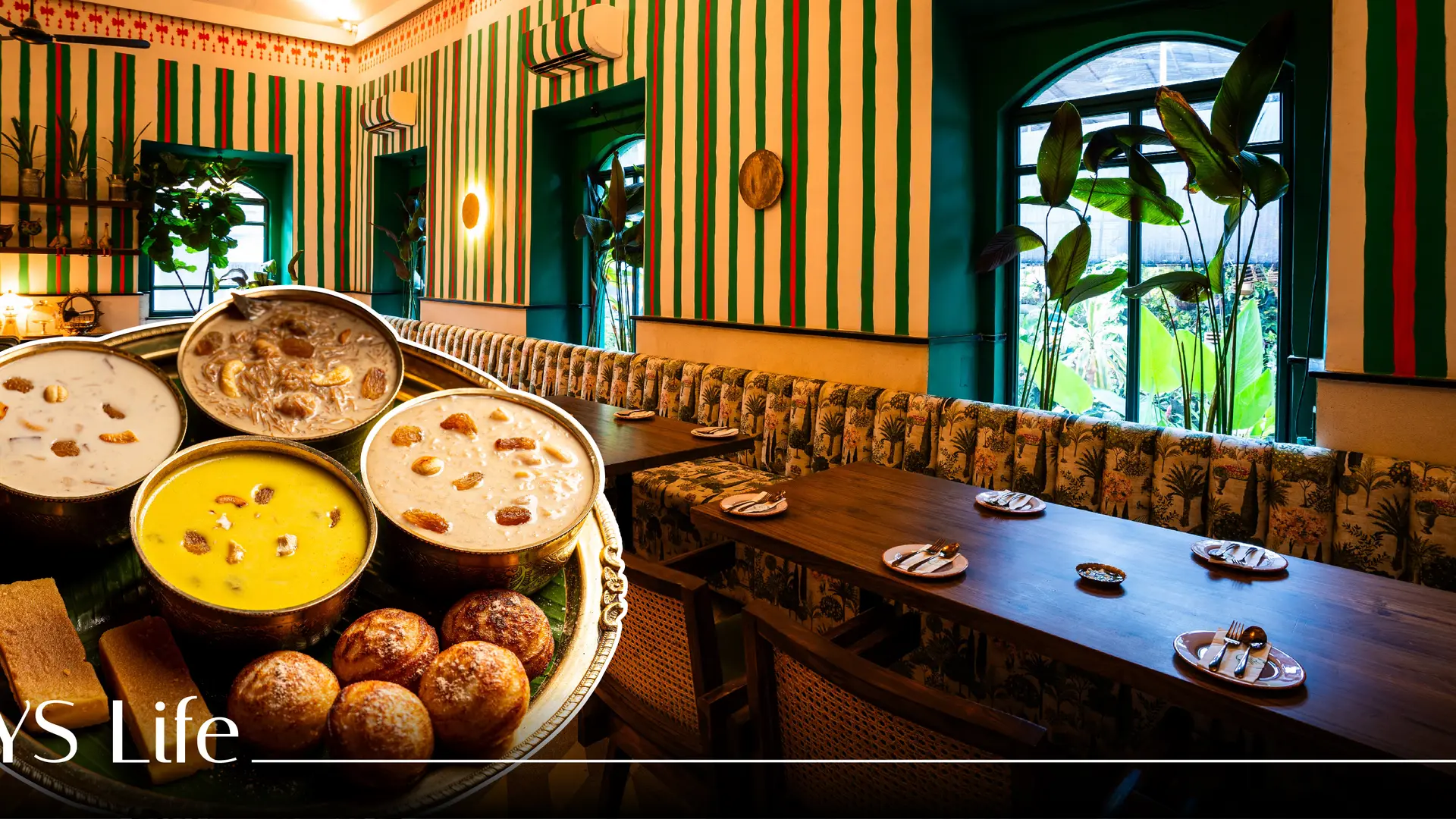THE Lotus Palace: a serene retreat in Chettinad with oodles of old-world charm
THE Lotus Palace is a 230-year-old house in Kanadukathan village, which has been carefully restored and converted into a heritage hotel by THE Park group of hotels. It promises a luxurious stay and plenty of immersive experiences to understand the culture of the region.
A colourful façade with intricate statues welcomes visitors to THE Lotus Palace, a heritage hotel in Kanadukathan, a village in the Chettinad region of Tamil Nadu. In a ‘mansion’ across the street, students of architecture are busy sketching and taking notes, while tourists look around curiously.
The vibrant entrance to the hotel stands in contrast to what the village resembles when all the visitors wind up for the day.
In the evening, Kanadukathan appears like a ghost town with hardly any people or movement, barring a dog or two darting around.
It’s hard to believe Chettinad was once a region throbbing with activity; there are only stray signs of that today. One may find more people and activity in nearby Karaikudi, a city that’s about 14 km away, but the buzzing days of the past are certainly behind.
Chettinad was the home of the Nattukottai Chettiars (also known as Nagarathars), a wealthy community of merchants and maritime traders. The golden era ended during the Second World War, when many of them began migrating to other cities and countries, leaving behind their palatial homes, often referred to as ‘mansions’.
While some Chettiar families come home for festivals or functions, others have converted their houses into hotels and museums.
THE Lotus Palace Chettinad is one such heritage hotel—a 230-year-old house that has been meticulously restored—retaining its old-world charm, without dramatically altering the building’s structure and overall aesthetics. It is the property of Apeejay Surrendra Park Hotels Ltd, under THE Park Collection brand of heritage properties, and was launched in October last year.
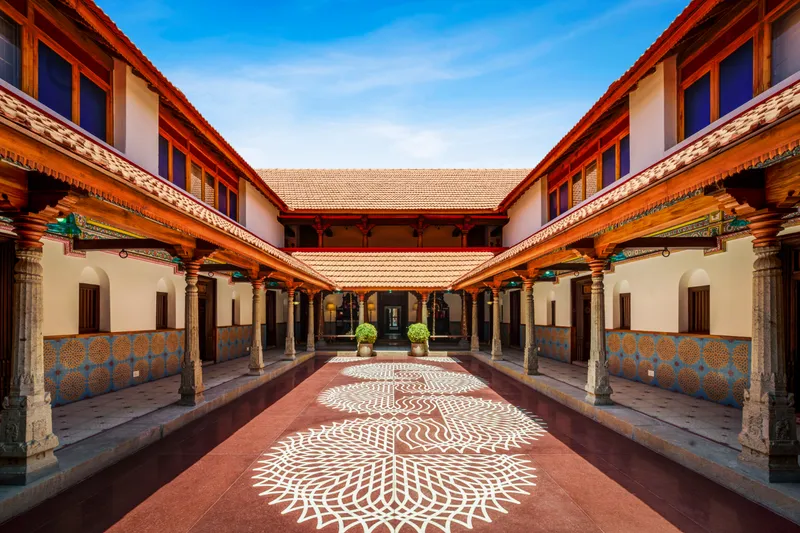
THE Lotus Palace Chettinad in Kanadukathan, a heritage village in Tamil Nadu, is a 230-year-old house meticulously restored and converted into a stunning heritage hotel by Apeejay Surrendra Park Hotels.
Kathiravan Karunanithi, the hotel’s manager, details the restoration process.
“We have retained 95% of the old elements in the property, which is the oldest house in Kanadukathan village. Since the original structure was unstable, it had to be strengthened and stabilised with scaffold to extend the life of the building. Floor tiles (handmade tiles from Athangudi) were laid anew, and minimal changes were made to the roofing. All this took about 4.5 years.”
Like with most Chettinad homes, this house too has walls plastered with a mix of egg white, egg shells, kadukkai (inknut), lemon, jaggery, red soil, and calcium. “This gives the walls sheen and also makes them strong,” says Karunanithi.
The walls have been largely left untouched, except for a layer of reinforcement.
The restoration was spearheaded by Kaushik Mukherjee, an architect who specialises in restoration of old buildings.
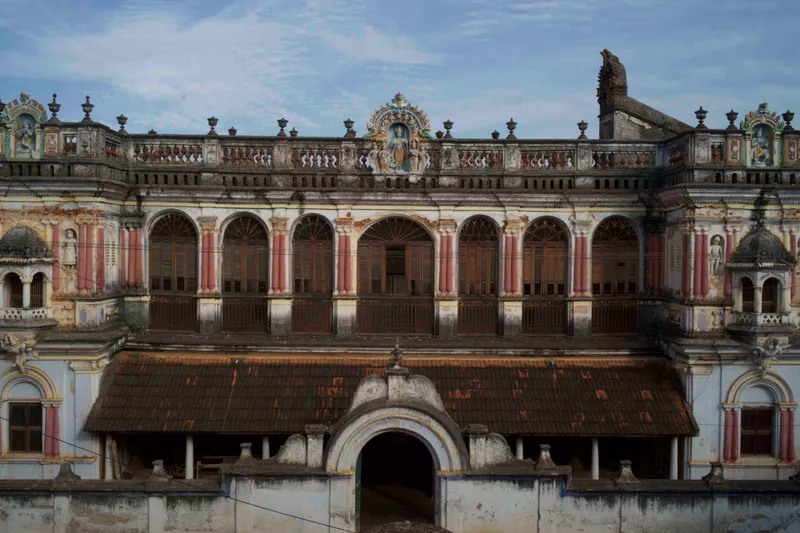
The original building before restoration
Blast from the past
The frontage of THE Lotus Palace, with its cheery disposition, serves as a reminder of how life would have been back in the days—when the house hosted readings of the Ramayana during the Tamil month of Purataasi, a period marked by prayers, rituals, and fasts.
The statues of Rama, Sita, Lakshmana, and Hanuman—Hindu deities from the epic—adorn the top of the façade. In fact, the house is still identified as ‘Ramayana House’ by the villagers.
In another reference to the past, the hotel has named its bar ‘1795’ to commemorate the year in which the house was built, while its restaurant is called ‘86 Pillars’, indicating the number of pillars across the property.
One can find plenty of antiques, enamelware, lacquerware, and Kottan (dried palm leaf) and baskets across the property, which lend an air of quaint charm.
Heritage comes alive
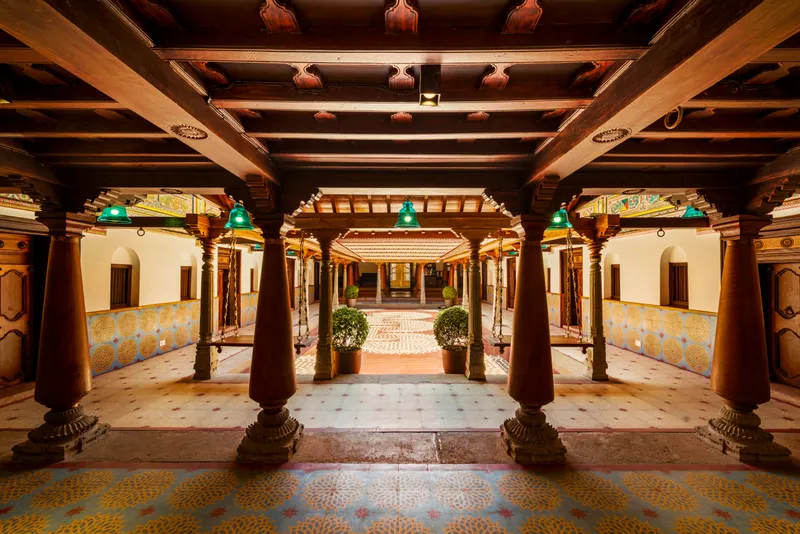
The central courtyard at THE Lotus Palace: Seen here are teak pillars, traditional swings, Athangudi tiles, and wooden beams, characteristic of traditional Chettinad buildings.
The most striking feature of THE Lotus Palace is the large kolam inlay work in granite, depicting the 1,000 petals of the lotus, running across the central courtyard. Besides this, the pillars around the hotel have a base shaped like a lotus. These elements ended up giving the hotel its name.
Up on the walls of the courtyard, traditional paintings in vivid colours add a decorative border, arousing one’s curiosity and interest.
“These were originally in black and white and were painted over with herbal pigments by sthapatis (architects) from Ramanathapuram district in Tamil Nadu,” notes Karunanithi.
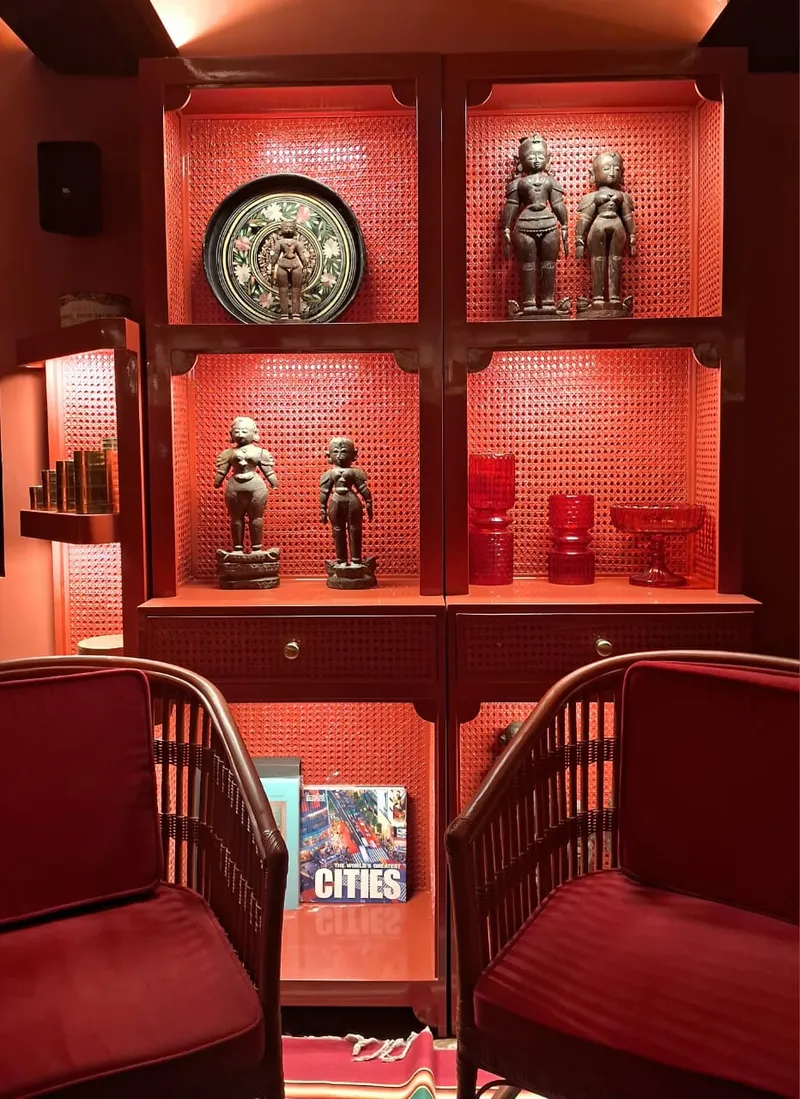
Antiques and artefacts at the Red Room
Other elements that catch the eye are the Burma teakwood pillars; cosy thinnais (shaded veranda) in front, where one can put the feet up and relax; and a pair of oonjal (traditional swing) in the courtyard.
“The thinnais were originally used as a place for financial transactions, as many Chettiars were moneylenders—one thinnai was used as an inward cash counter and another as an outward cash counter,” shares Karunanithi.
Evenings are special at the hotel, with high tea being served at a Burmese-themed ‘Red Room’ on the first floor. Blending Tamil Nadu aesthetics and Burmese artefacts predominantly in the hues of red, the private lounge celebrates the strong connection that the Chettiar community had with Burma (now Myanmar).
“The lacquerware in the room was purchased from the antique markets of Burma,” says Karunanithi.
Through the Red Room, one can go up to the terrace, which offers a panoramic view of the village and plenty of fresh air.
Delhi’s restored havelis offer a blueprint for adaptive reuse in urban conservation projects
Where heritage meets luxury
THE Lotus Palace is a serene retreat merging heritage with contemporary luxury.
Priya Paul, Chairperson, Apeejay Surrendra Park Hotels, says, “This hotel emboldens our commitment to honouring and preserving India’s diverse legacy, by carefully turning historic spaces into living stories.”
The original rooms of the house, which were smaller, were combined to create bigger rooms and suites. Modern fixtures, amenities, and furniture were added to make the rooms amply comfortable.
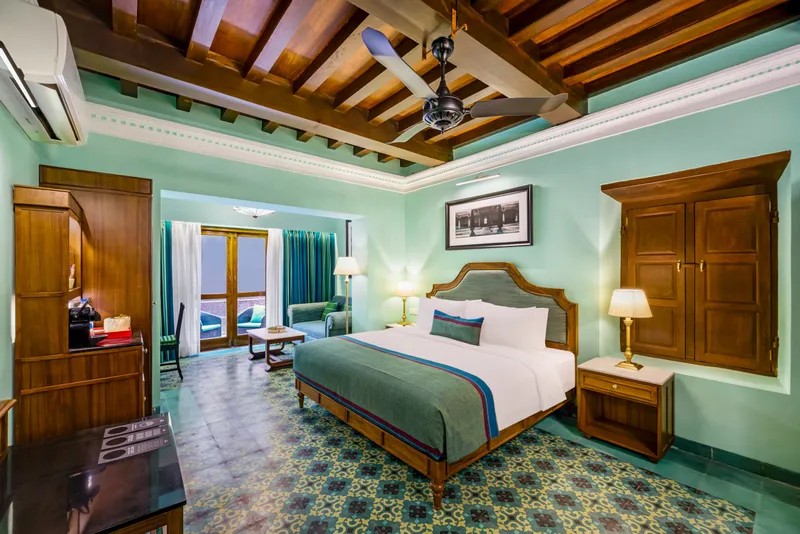
A luxurious room with modern amenities and traditional aesthetics at THE L:otus Palace Chettinad
THE Lotus Palace pampers guests with spa services and a raja virundhu—a royal thali featuring several traditional dishes from Chettinad/Tamil cuisine.
On our trip, we savour a grand vegetarian feast, starting with thattai (a traditional Tamil Nadu snack) with hummus, followed by banana stem soup. “This is the Burmese style soup usually served with Atho noodles,” explains Chef Vinoth.
The sweets of the day are ukkarai, a delicacy made with moong dal and jaggery, and payasam (kheer) made with Kavuni black rice.
The non-vegetarian thali includes Chettinad chicken, fish fry, and mutton uppu kari (salted stir fry).
Immersive experiences
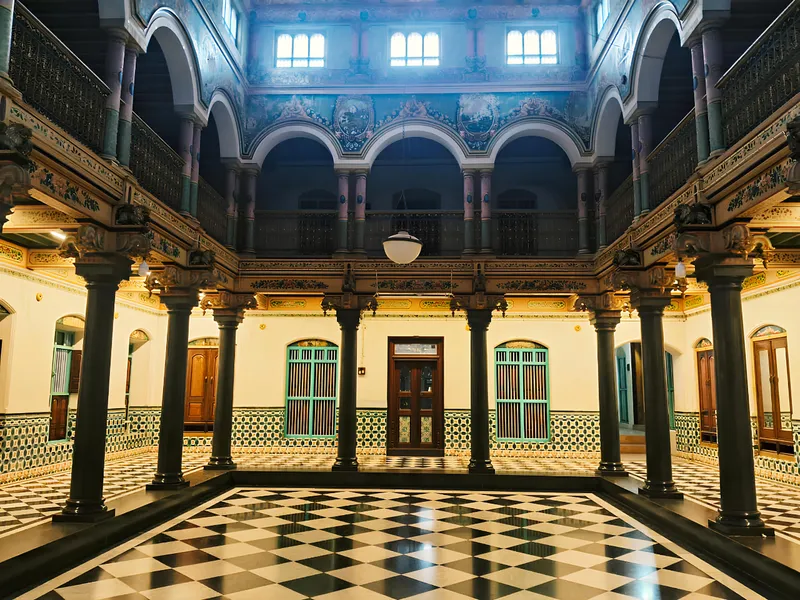
Athangudi Palace, a true masterpiece of Chettinad architecture
The Chettiar community originally lived in Poompuhar, an ancient port city near Puducherry. When Poompuhar was swallowed by a tsunami, the Chettiars had to seek newer pastures.
Around 8th century BC, the then Pandya king is said to have offered land to them—this now forms the Chettinad region, straddling Pudukkottai and Sivaganga districts, comprising 76 villages.
“Kanadukathan in Tamil can be read as: kaanaadha naadu kaathan, which roughly translates to ‘an unknown land made prosperous’ by the Chettiars,” explains Karunanithi, a native of the region who takes great pride in its rich history and culture.
To help understand the land and its culture better, THE Lotus Palace offers immersive experiences to its guests. They include nadu veettu kolam (learning to draw kolam), kili josiyam (astrology), and traditional boardgames like Pallankuzhi and Paramapadham.
Kolam is an art form of South India that involves drawing geometric patterns on the ground using rice flour. In kili josiyam, which is similar to tarot card reading, a parrot picks a card from a collection with its beak, which the astrologer interprets to predict one’s future.
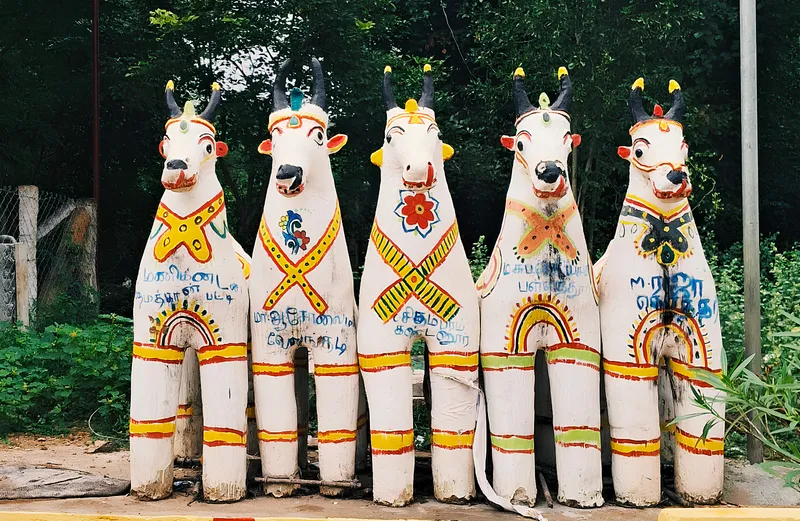
Devotees commission and offer giant terracotta horses made by local potters at the Ayyanar temple as a thanksgiving gesture.
Guests are also taken on a neighbourhood tour around the streets of Kanadukathan to explore Chettiar houses, which showcase a mix of Tamil and European architecture.
As Chettiars travelled around the world a lot, it’s common to find Belgian glass and tiles from Belgium, Spain, and Portugal in their houses.
“In fact, the dining table was probably brought to Tamil Nadu by the Chettiars who saw this practice during their travels abroad,” remarks Karunanithi.
Besides traditional houses, visitors are taken to an antique market in Karaikudi, heritage museums, and a handloom weaving centre known for Kandangi cotton sarees. Athangudi Palace, Thirumayam Fort, and a few temples in the region are also part of the itinerary.
During our trip, we visit a temple in Pillaiyarpatti, one of the nine important temples of the Nagarathar community, dedicated to Lord Ganesha.
We also make an impromptu stop at the Ayyanar temple, where huge quirky-looking horses made of terracotta are offered by devotees to Ayyanar, a folk deity who’s considered the village guardian.
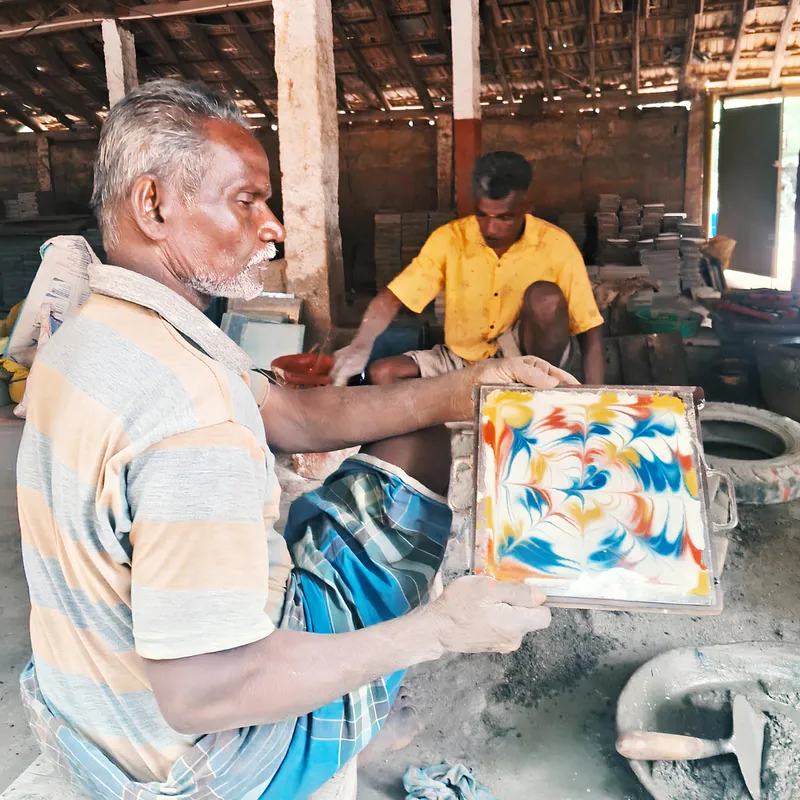
An artisan proudly displays a handmade Athangudi tile with the spider web design.
“This is done as thanksgiving for good health and prosperity,” points out our tour-guide, Kavitha.
No visit to Chettinad is complete without stopping by the tile factory in Athangudi, which makes handmade tiles using a mix of cement, river sand, and coloured oxides.
As patterns like the poochi koodu (spider web) and sokkataan (a geometric pattern inspired by the Ludo boardgame) burst onto the tiles, we are awestruck by their stunning colours and rustic simplicity.
Room tariff at THE Lotus Palace: Starts at Rs 18,000 plus taxes, per night, including breakfast; Experiences are charged separately
(The author was on a visit to Chettinad on the invitation of THE Lotus Palace.)
(The copy was updated.)
Edited by Megha Reddy



